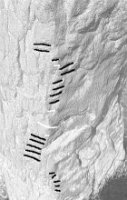For the history of the discovery of the stones from Glenawillin cf. no. 63.
This stone remained on the site and was erected in a field belonging to Ballytrasna House. It was visited by G.M. Atkinson together with E. Barry, J.J. Smyth, and James Brenan on the 22.8.1881; according to Atkinson, Windele had inspected it on the 22.9.1848. At that time it stood on an "erased rath in (an) adjoining field" (JRSAI 16, 1884, 309).
Size according to Macalister, CIIC: 6'4" x 1'8" x 1'0".
Published illustrations:
- Atkinson, JRSAI 16, 1884, 308 (draft);
- Macalister, Epig. 3, 41 (draft);
- Macalister, CIIC 1, 69 (sketch).
Published photographs:
Macalister, CIIC 1, 68.
Reading Abell (according to a Windele-Ms., quoted by Macalister, CIIC 69, n. 1):
LADEBMNUDHMI
According to Macalister, EB must have been misread for I, and UD for I here.
ALADQ M N CATT
ALADCU M(AQI) NOCATT(I)
For cp. Aladchu in the Annals of the Four Masters; for NOCATT cp. NOCATI in Whitefield {217} and NOGATI in Drumlohan / Waterford {272}.
IQAMILOD
The lettering is inverted, it has to be read from right to left: DOLI MAQI. The following letters were removed by a "flake"; according to Windele, the letters ANF were still readable at his time. "Possibly some characters are still buried, and the name may yet be ascertained."
LODIMANI
Brash's reading ALADQ "may pass muster", but there is no basis for his N(o)catt; this may have arisen by confusion with the notes concerning no. 63 {63} because NOCATT can be taken as an inversion of a damaged BRUSCO. The notches of 1I are quite long, so that they could be misread as Q by Brash. O2 is "a little broken", A and the "lower half of" M "are obscure". - "There seems to be no continuation of the inscription buried in the earth". This stone has to be read downward like the one from Kinnard East {188}, because N could otherwise have continued on the edge. Atkinson's DOLI MAQI can be ruled out. For "names in -manus cp. Cata-manus, Tascio-manus, Viro-manus a.o., also Manu in Drumloghan I {272} which "is probably an abbreviation of Manus". - LODIMANI "is suggestive of Liamhain, the name of one of St. Patrick's sisters."
LODIMONI
Although the downward direction of the writing makes it suspicious, it is not probable that the stone was formerly erected upside-down. - As the second letter, we have to read O instead of A as in former publications; O1 "is there, but very faint". Brash's reading obviously depends on Windele's; at that time, the stone was still standing in the souterrain, so that there was no chance at all of reading NOCATT. 1A in his ALADQ is equally "unjustifiable"; -Q is misread for I, and N was inverted into a second Q. - [Note 1:] Abell's "pathologically inaccurate copy" suggests that the N of NOCATT could be identical with the N in LODIMONI which also invoked the Q of MAQI.
[N.B. -AQI was not read by Brash but only proposed as a filling element for the gap between M and N.]
LADIMANI
There is no basis for reading -O- instead of the -A- letters.
LADIMANI
O'Kelly's reading has to be preferred as against Macalister's.
Reading Gippert (1978):
 Angle down:
Angle down:
L[O]D(I)[MA]NI
èâ[â]ìå(ä)[ïâ]êéåä
ççâ[â]ëëââââ[âïâ]çççççâââââ
The stone would have to be dug up for verification of the part now hidden in the ground. - The middle of what can be read today is hardly conceivable; whether there was a second vowel notch below the M cannot be regarded as certain at all. As against O'Kelly's statement, the first vowel may well have been intended as an ã O, part of the angle having broken between this and the D; but cp. Macalister's photograph in CIIC 1, 68, where only one vowel notch is marked by whitening.
Last changes of this record: 26.04.97
Copyright Jost Gippert, Frankfurt a/M 1996. No parts of this document may be republished in any form without prior permission by the copyright holder.  Angle down:
Angle down:





